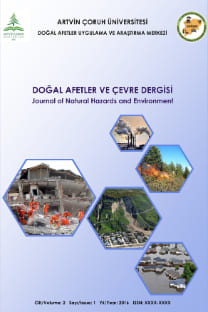Türkiye Bina Deprem Yönetmeliğine (2018) Göre Sıvılaşma Potansiyeli Analizi ve Sığacık (Seferihisar/İzmir) Örneği
Liquefaction Analysis According to Turkish Building Earthquake Regulation (2018) and Sığacık (Seferihisar/İzmir) Case Study
___
- Akbuğa E., (2019), Seferihisar (İzmir) bölgesinde sıvılaşma analizi ve haritalandırılması, Yüksek Lisans Tezi, Manisa Celal Bayar Üniversitesi, Manisa, Türkiye.
- Bray J.D., Macedo J., (2017), 6th Ishihara lecture: Simplified procedure for estimating liquefaction-induced building settlement, Soil Dynamics and Earthquake Engineering, 102, 215-231.
- Cetin K.O., Seed R.B., Der Kiureghian A., Tokimatsu K., Harder L.F., Kayen R.E., Moss R.E.S., (2004), Standard penetration testbased probabilistic and deterministic assessment of seismic soil liquefaction potential, J. Geotech. Geoenviron. Eng., 130(12), 1314-1340.
- Çetin K.O., Bilge H.T., Wu J., Kammerer A.M., Seed R.B., (2009), Probabilistic model for the assessment of cyclically-induced reconsolidation (volumetric) settlements, J. Geotech. Geoenviron. Eng., 135(3), 387-398.
- Çetin K.O., Bilge H.T., (2010), Zeminlerin sismik yükleme altında deformasyon ve mukavemet davranışlarına kritik bakış, Zemin Mekaniği ve Temel Mühendisliği 13. Ulusal Kongresi, 30 Eylül - 1 Ekim, İstanbul Kültür Üniversitesi, İstanbul, Türkiye.
- Drahor M.G., Sarı C., Şalk M., (1999), Seferihisar jeotermal alanında doğal gerilim (SP) ve gravite çalışmaları, 9 Eylül Üniversitesi Mühendislik Fakültesi, Fen ve Mühendisliği Dergisi, 1(3), 97-112.
- Emre Ö., Özalp S., Doğan A., Özaksoy V., Yıldırım C., Göktaş F., (2005), İzmir yakın çevresinin diri fayları ve deprem potansiyelleri, MTA rapor no:10754, Maden Tetkik ve Arama Genel Müdürlüğü, Jeoloji Etütleri Dairesi, Ankara, 80ss.
- Erdoğan B., (1990), İzmir-Ankara Zonu ile Karaburun kuşağının tektonik ilişkisi, M.T.A. Dergisi, 110, 1-15.
- Huang Y., Yu M., (2013), Review of soil liquefaction characteristics during major earthquakes of the twenty-first century, Natural Hazards, 65, 2375-2384.
- Hyde A.F.L., Higuchi T., Yasuhara K., (2006), Liquefaction, cyclic mobility, and failure of silt, J. Geotech. Geoenviron. Eng., 132(6), 716-735.
- Ishihara K, Yoshmine M., (1992), Evaluation of settlements in sand deposits following liquefaction during earthquakes, Soils and Foundations, 32(1), 173-188.
- Isobe K., Ohtsuka S., Nunokawa H., (2014), Field investigation and model tests on differential settlement of houses due to liquefaction in the Niigata-ken Chuetsu-Oki earthquake of 2007, Soils and Foundations, 54(4), 675-686.
- ISSMGE/TC4, (1999), Manual for zonation on seismic geotechnical hazards, Tech. Com. For Earthquake Geotechnical Engineering TC4, ISSMGE, Japanese Society of Soil Mechanics.
- İnci U., Sözbilir H., Sümer Ö., Erkül F., (2003), Urla-Balıkesir arası depremlerin nedeni fosil bir fay, Cumhuriyet Bilim ve Teknik Dergisi, 21, 7-8.
- Karakan E., Tanrinian N., Sezer A., (2019), Cyclic undrained behavior and post liquefaction settlement of a nonplastic silt, Soil Dynamics and Earthquake Engineering, 120, 214-227.
- Mele L., Flora A., (2019), On the prediction of liquefaction resistance of unsaturated sands, Soil Dynamics and Earthquake Engineering, 125, 105689, doi: 10.1016/j.soildyn.2019.05.028.
- Mele L., Tan Tian J., Lirer S., Flora A., Koseki J., (2019), Liquefaction resistance of unsaturated sands: experimental evidence and theoretical interpretation, Geotechnique, 69(6), 541-553.
- MTA, (2018), Türkiye jeoloji haritası/geological map of Turkey, http://www.mta.gov.tr/v3.0/sayfalar/hizmetler/doc/IZMIR.pdf, [Erişim 20 Şubat 2018].
- Ocakoğlu N., Demirbağ E., Kuşçu İ., (2004), Neotectonic structures in the area offshore of Alaçatı, Doğanbey and Kuşadası (western Turkey): evidence of strike-slip faulting in the Aegean extensional province, Tectonophysics, 391(1-4), 67-83.
- Ocakoğlu N., Demirbağ E., Kuşçu İ., (2005), Neotectonic structures in İzmir Gulf and surrounding regions (western Turkey): Evidences of strike-slip faulting with compression in the Aegean extensional regime, Marine Geology, 219(2-3), 155-171.
- Takch E.A., Sadrekarimi A., Naggar E.H., (2016), Cyclic resistance and liquefaction behavior of silt and sandy silt soils, Soil Dynamics and Earthquake Engineering, 83, 98-109.
- TBDY, (2018), Türkiye bina deprem yönetmeliği, Resmi Gazete, Tarih: 18 Mart 2018, Sayı: 30364, https://www.resmigazete.gov.tr/ eskiler/2018/03/20180318M1-2.htm, [Erişim 20 Şubat 2018].
- Thevanayagam S., Martin G.R., Shenthan T., Liang J., (2001), Post-liquefaction pore pressure dissipation and densification in silty soils, Fourth International Conference on Recent Advances in Geotechnical Earthquake Engineering and Soil Dynamics, 26-31
- March, Missouri University of Science and Technology, Rolla, Missouri, USA.
- UDİM, (2005), 17-21 Ekim 2005 Sığacık Körfezi –Seferihisar (İZMİR) depremleri ön değerlendirme raporu, Boğaziçi Üniversitesi, Kandilli Rasathanesi ve Deprem Araştırma Enstitüsü, Ulusal Deprem İzleme Merkezi, 6 ss.
- Yılmazer S., (1979), İzmir Seferihisar (URLA L17-C1) yöresinin jeolojisi, MTA rapor no:6834, Maden Tetkik ve Arama Genel Müdürlüğü, Jeoloji Etütleri Dairesi, Ankara.
- Youd T.L., Idriss I.M., Andrus R.D., Arango I., Castro G., ……, Stokoe K.H., (2001), Liquefaction resistance of soils: Summary report from the 1996 NCEER and 1998 NCEER/NSF workshops on evaluation of liquefaction resistance of soils, Journal of Geotechnical and Geoenvironmental Engineering, 127(10), 817-833.
- Yoshimi Y., Tanaka K., Tokimatsu K., (1989), Liquefaction resistance of a partially saturated sand, Soils and Foundations, 29(3), 157-162.
- ISSN: 2528-9640
- Yayın Aralığı: Yılda 2 Sayı
- Başlangıç: 2015
- Yayıncı: Artvin Çoruh Üniversitesi Doğal Afetler Uygulama ve Araştırma Merkezi
Yerel Yönetimler İçin Karbon Ayak İzinin Belirlenmesi: Ümraniye Belediyesi Örneği
B. Hande GÜRSOY HAKSEVENLER, G. Nur ÇELİK ONAT, Begüm AKPINAR, Tuğba BEDEL
Yerdeğiştirme Tabanlı Deprem Erken Uyarı Sistemleri
Murat Doruk ŞENTÜRK, Bahadır AKTUĞ
Sürdürülebilirliğin Temel Taşı: Ekolojik Ayak İzi
Ece TUĞBA MIZIK, Zehra YİĞİT AVDAN
Orman Yangın Yönetiminde Etkili Bir Karar Destek Sisteminin Kavramsal Çerçevesi
KADİR ALPEREN COŞKUNER, Ertuğrul BİLGİLİ
Hakan ERSOY, Murat KARAHAN, Hasan Hüseyin ÖZTÜRK
Uluabat Gölü Noktasal Kirletici Kaynaklar ve Kirlilik Yükleri
Saadet HACISALİHOĞLU, Feza KARAER
Farklı Malzemeler ve Geosentetiklerin Yol Dolgusu Güvenliğine ve Davranışına Etkileri
Yusufeli Barajı Antropojenik Etkilerinin Peyzaj Planlama Açısından Değerlendirilmesi
